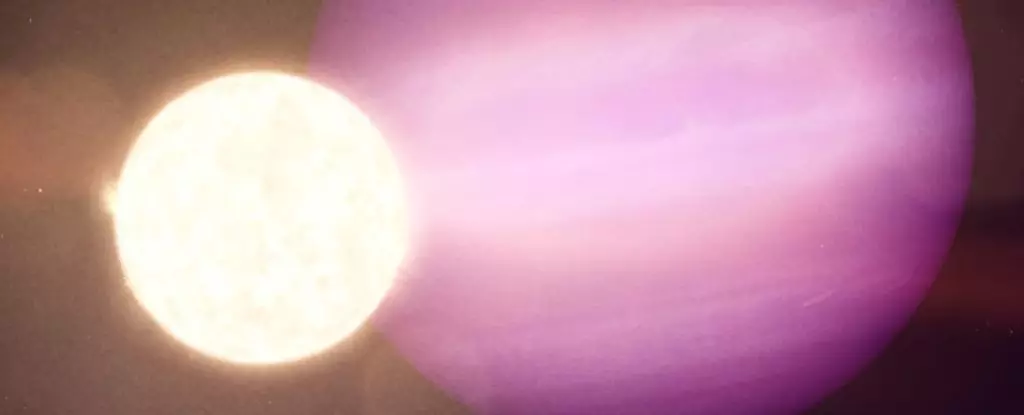In recent years, the quest to uncover exoplanets, particularly those that may harbor life, has entered a thrilling new phase, thanks to revolutionary advancements in space telescopes. The James Webb Space Telescope (JWST) stands at the forefront of this endeavor, fundamentally altering our perspective on distant worlds. As we delve deeper into the cosmos, one intriguing discovery has captured the attention of astronomers and the public alike: WD 1856+534 b, a gas giant orbiting a white dwarf star located 81 light-years from Earth. This “super-Jupiter,” as it’s dubbed, raises critical questions not just about its own characteristics but also about the resilience of planets in extreme environments following stellar evolution.
Unveiling WD 1856+534 b
Discovered in 2020, WD 1856+534 b is classified as a super-Jupiter due to its staggering mass—approximately six times that of our Solar System’s largest planet. What makes this exoplanet particularly fascinating is its unique position in relation to its host star, a white dwarf. This pairing is vital for astronomers to study, as white dwarfs are the remnants of sun-like stars that have exhausted their nuclear fuel. The dramatic changes these stars undergo stir a multitude of implications for planetary systems orbiting them. Conclusively observing WD 1856+534 b through JWST’s Mid-Infrared Instrument (MIRI) marks a significant scientific milestone. Notably, this exoplanet has been characterized as the coldest ever detected, with a frigid average temperature of about 186 K (-87 °C).
The Role of the James Webb Space Telescope
The capabilities of the JWST are nothing short of groundbreaking. The instrument is designed with sophisticated infrared optics and spectrometers that enable in-depth analysis of distant celestial bodies. The primary goal of monitoring WD 1856+534 b is not merely to acknowledge its existence but to understand its atmospheric composition, formation, and even the potential for habitability. Given that identifying the chemical signatures present in a planet’s atmosphere could hint at life as we know it, observers are eagerly leveraging JWST to scrutinize the light reflected from the exoplanet’s surface and atmosphere.
Detecting exoplanets is not an easy feat. The overwhelming brightness of host stars often obscures the much fainter light reflected by orbiting planets. This challenge means that direct imaging strategies have predominantly focused on more massive gas giants that orbit at wider distances. However, with white dwarf hosts like WD 1856+534, astronomers discover an advantageous situation where reduced luminosity allows for more accessible observation.
The Significance of Cold Exoplanets
WD 1856+534 b presents an unprecedented opportunity to study planetary survivability in the wake of stellar evolution. Historically, no terrestrial or rocky planets have been documented orbiting close to their stars under conditions similar to those offered by white dwarfs. By examining how planets function and thrive near these remnants, we gain insights into their orbital stability and evolutionary paths.
Critically, understanding the characteristics of WD 1856+534 b can reveal broader patterns about planetary systems that endure transition phases from main-sequence life to white dwarfs. As scientists ponder the question of habitability in extreme environments, WD 1856+534 b further solidifies the idea that life may not be exclusively tied to planets orbiting main-sequence stars.
Future Perspectives and Implications
The international collaboration involved in studying WD 1856+534 b reflects a vigorous community committed to unraveling astronomical mysteries. Lead researcher Mary Anne Limbach and her team have articulated the significance of their work, emphasizing that the JWST’s observations could decipher whether planets have possibly been relocated into close orbits due to stellar transformations. Their revelation that WD 1856+534 b can survive and thrive in such extreme conditions opens up a plethora of questions regarding the nature of planetary migration.
Looking ahead, further observations scheduled for 2025 will enhance our understanding of this alien world and its potential neighbors. The data captured by the JWST’s near-infrared spectronometer (NIRSpec) will provide additional context about this enigmatic planet, paving the way for future explorations and potentially life-detecting avenues in exoplanetary research.
With each breakthrough, astronomy evolves, tantalizingly edging closer to revealing the secrets of the universe, forcing us to reconsider where we might find life beyond our own celestial home. The discovery of WD 1856+534 b not only adds a new player to the roster of known exoplanets but also beckons the search for understanding how planets endure cosmic reckonings.


Leave a Reply